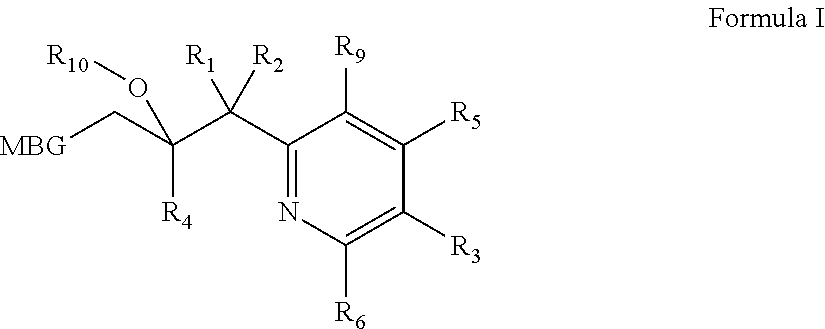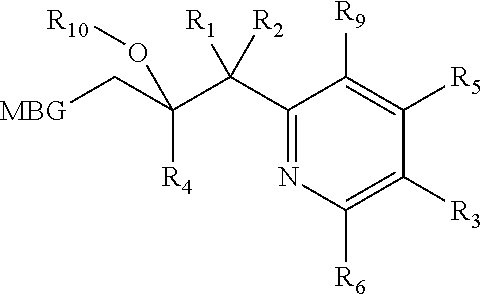Metalloenzyme inhibitor compounds
a technology of enzyme inhibitors and compounds, applied in the field of metaloenzyme inhibitor compounds, can solve the problems of no single fungicide is useful in all situations, and the activity of enzymes is dramatically decreased
- Summary
- Abstract
- Description
- Claims
- Application Information
AI Technical Summary
Benefits of technology
Problems solved by technology
Method used
Image
Examples
example 1
[0348]
1-(5-Bromopyridin-2-yl)-2-(2,4-difluorophenyl)-1,1-difluoro-3-(1H-tetrazol-1-yl)propan-2-ol (1)
[0349]To a stirred solution of tetrazole (248 milligrams (mg), 3.54 mmol) in N,N-dimethylformamide (DMF; 10 milliliters (mL)) was added potassium carbonate (K2CO3) (244 mg, 3.54 mmol) followed by epoxide F (1.28 grams (g), 3.54 mmol). The reaction mixture was stirred for 3 h at 60° C. The volatiles were removed under reduced pressure. The residue was taken into EtOAc and washed with brine, washed with water, and dried over anhydrous Na2SO4. Purification by column chromatography (eluting with EtOAc / hexane) afforded compound 1 (350 mg, 0.81 mmol, 23%) as a pale yellow powder. 1H NMR (500 MHz, CDCl3): δ 8.74 (s, 1H), 8.62 (s, 1H), 7.94 (d, J=7.50 Hz, 1H), 7.46 (d, J=9.0 Hz, 1H), 7.31-7.26 (m, 1H), 6.88 (s, 1H), 6.78-6.74 (m, 1H), 6.70-6.67 (m, 1H), 5.60 (d, J=14.50 Hz, 1H), 5.11 (d, J=14.50 Hz, 1H). MS (ESI): m / z 432, 434 [M++2]. HPLC: 95.65%.
[0350]Compounds 19-27 in Table 1 were prepar...
example 2
[0351]
2-(2,4-Difluorophenyl)-1,1-difluoro-1-(pyridin-2-yl)-3-(1H-tetrazol-1-yl)propan-2-ol (2)
[0352]To a stirred solution of tetrazole (49 mg, 0.7 mmol) in DMF (5 mL) was added K2CO3 (49 mg, 0.35 mol) followed by the analogous epoxide (prepared starting from 2-bromopyridine using the synthesis shown in Scheme 2; 200 mg, 0.7 mmol). The reaction mixture was stirred for 4 h at 65° C. The volatiles were removed under reduced pressure and extracted with EtOAc (2×20 mL). The organic layer was washed with water, washed with brine, and dried over anhydrous Na2SO4. The crude compound was purified by column chromatography (eluting with EtOAc / hexane) to afford compound 2 (30 mg, 0.09 mmol, 12%) as white solid. 1H NMR (500 MHz, CDCl3): δ 8.75 (s, 1H), 8.55 (d, J=4.0 Hz, 1H), 7.84-7.82 (m, 1H), 7.75 (s, 1H), 7.59 (d, J=7.50 Hz, 1H), 7.45-7.43 (m, 1H), 7.34-7.26 (m, 1H), 6.78-6.76 (m, 1H), 6.67-6.64 (m, 1H), 5.58 (d, J=13.50 Hz, 1H), 5.12 (d, J=13.50 Hz, 1H). HPLC: 95.42%. MS (ESI): m / z 354 [M++1...
example 3
[0355]
(E)-3-(6-(2-(2,4-Difluorophenyl)-1,1-difluoro-2-hydroxy-3-(1H-tetrazol-1-yl)propyl)pyridin-3-yl)acrylonitrile (3)
[0356]To a stirred solution of F (1.0 g, 2.76 mmol) in DMF (10 mL) were added acrylonitrile (0.52 g, 9.9 mmol), a catalytic amount of tetrabutylammonium bromide (TBAB), and sodium bicarbonate (NaHCO3; 0.27 g, 3.32 mmol) at RT under nitrogen (N2) atmosphere. After the mixture was purged with argon for a period of 30 min, palladium(II) acetate (Pd(OAc)2; 0.18 g, 0.82 mmol) was added. The temperature was elevated to 110° C. and stirring was continued for 4 h. After complete consumption of starting material, the reaction mixture was cooled, the volatiles were evaporated under reduced pressure and the obtained residue was dissolved in EtOAc (250 mL). The organic layer was washed with water (2×50 mL), brine (50 mL) and dried over anhydrous Na2SO4. After filtering off the solid, the solvent was evaporated under reduced pressure to give crude compound. The crude material wa...
PUM
 Login to View More
Login to View More Abstract
Description
Claims
Application Information
 Login to View More
Login to View More - R&D
- Intellectual Property
- Life Sciences
- Materials
- Tech Scout
- Unparalleled Data Quality
- Higher Quality Content
- 60% Fewer Hallucinations
Browse by: Latest US Patents, China's latest patents, Technical Efficacy Thesaurus, Application Domain, Technology Topic, Popular Technical Reports.
© 2025 PatSnap. All rights reserved.Legal|Privacy policy|Modern Slavery Act Transparency Statement|Sitemap|About US| Contact US: help@patsnap.com



